As a homeowner in Portland, you may have a prefabricated fireplace and chimney system in your residence. These efficient and cost-effective heating solutions are common in many homes, but it’s crucial to understand the potential risks they face during the city’s severe winter storms. In this article, we’ll explore how these weather events can damage a prefabricated chimney, the signs you can look out for, and what you can do to protect your home and family.
This article was written by Portland Fireplace and Chimney – Portland’s #1 Fireplace and Chimney experts. We are the president of the regional chimney sweep guild and instructors with the National Chimney Sweep Guild. There is no higher qualified resource in Portland or the Pacific Northwest than us to keep your chimney and fireplace operational and safe.
What is a Prefabricated Fireplace and Chimney?
Prefabricated fireplaces and chimneys are factory-built systems made primarily of sheet metal. They consist of a firebox, a chimney flue, and a chase that encloses the flue. The chase is typically constructed with wood framing, covered with waterproof barriers, and finished with various siding materials such as brick, stucco, or cedar shakes. At the top of the chase, you’ll find a metal chase cover and a termination cap, which protects the chimney from the elements.
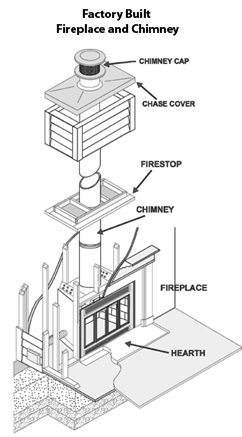
Unlike traditional masonry chimneys built with brick and mortar, prefabricated systems are designed for quick installation and are more affordable. However, their metal construction and lighter weight make them more susceptible to damage from severe weather.
The Advantages of Prefabricated Fireplaces and Chimneys
Despite their vulnerability to storm damage, prefabricated fireplaces and chimneys offer several benefits to homeowners:
1. Cost-effective: Prefabricated systems are generally less expensive than traditional masonry chimneys, making them a popular choice for many homeowners.
2. Efficient heating: Modern prefabricated fireplaces are designed to provide efficient heating, helping to reduce energy costs and keep your home warm during the colder months in Portland.
3. Versatile design options: Prefabricated fireplaces come in a variety of styles and finishes, allowing you to choose a design that complements your home’s interior décor.
4. Easy installation: Unlike masonry chimneys, which can take weeks to build, prefabricated systems can be installed quickly, often in just a few days.
How Portland’s Winter Storms Affect Prefabricated Chimneys
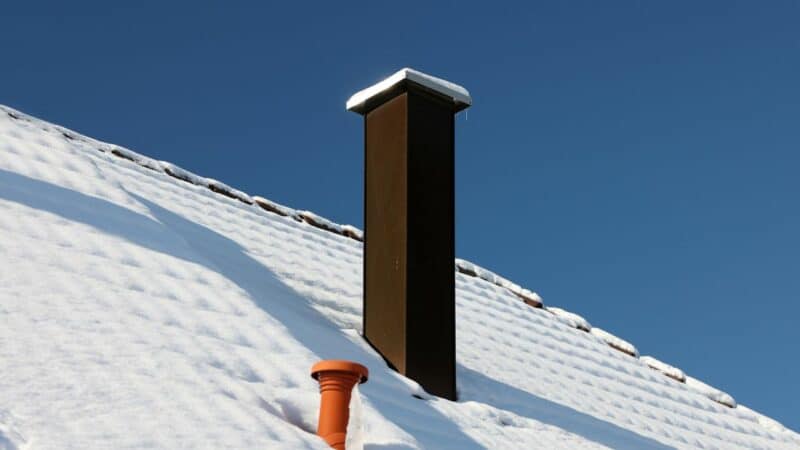
During our winter months, Portland experiences heavy rain, snow, and ice storms. Especially with the seasonal winter storm that have been common the last few years, these extreme weather conditions take a toll on your prefabricated chimney system:
1. Ice and Snow Accumulation on the Chase Cover
Ice and snow accumulation on the chase cover can cause it to sag or deform, as the thin sheet metal may lack the structural strength to support the extra weight. This can lead to broken seals around the chimney pipe, allowing water to infiltrate the chase.
2. Water Infiltration and Damage to the Chimney Chase
Like most chimney types, the biggest risk to the structural integrity of your chimney is water damage. If the waterproofing layers become even slightly compromised, water seeps into the chimney chase, and causes the wood framing to rot. As the water penetrates, it either runs through your system or freezes. Freezing water breaks the material bonds in your waterproof layer which leads to further degradation.
This is one of the most common issues we find on houses in Portland. The original builders are not chimney experts and the standard specifications for chase covers in our region is not sufficient for the freezing winter storms we’ve faced lately. This means that the weight of the snow and ice is not properly accounted for and we see breaks at exactlywhere the exhaust pipe hits the chase cover. There is a special seal called the storm crawler flashing that is supposed to help prevent water from the join of the pipe to the cover. This collar gets weighted down so that the chase cover basically pulls apart the chimney pipe.
Once the chase cover is compromised water starts to go around the chimney pipe and infiltrate the wood framing, siding, veneer and all the materials used to waterproof the chimney chase start to get saturated.
3. Damage to the Chimney System
Moisture intrusion can cause extensive damage to the chimney system itself. Rusting of pipe joints and connections to the firebox can occur, and gas control mechanisms may malfunction due to exposure to water.
Repairing and Replacing Damaged Prefabricated Fireplace Systems
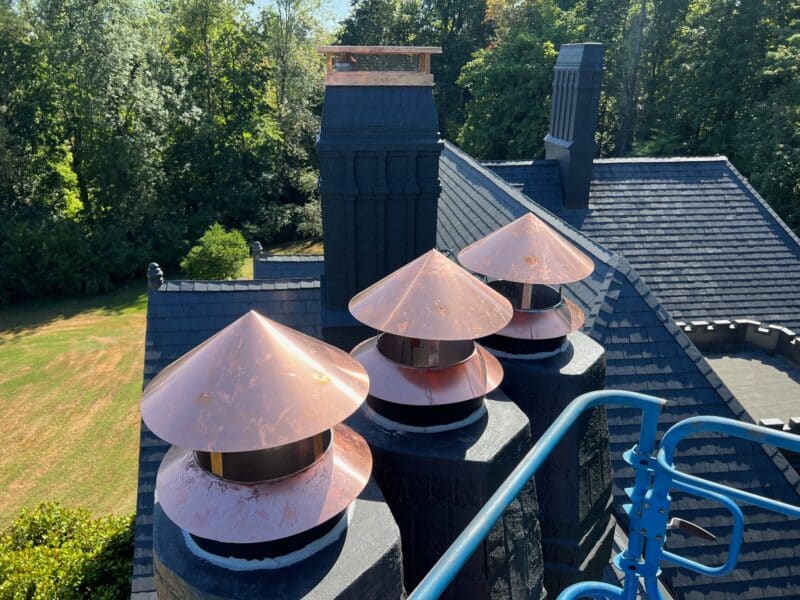
If your prefabricated chimney has suffered storm damage, repairs or replacement may be necessary. However, due to the Underwriters Laboratories (UL) listing and manufacturer requirements, finding compatible replacement parts can be challenging, especially for older systems. Many of these prefabricated fireplace systems are considered appliances and they have a UL listing. UL stands for Underwriters Labratory – that means that it has gone through testing in a labratory and every component on that system has to come directly from the manufacturer who built it. If the system is older than 20 years old then the manufacturer will no longer have any replacement systems available and the entire system has to be removed and replaced with a new system of like size and quality.
The problem is that in a lot of cases, the entire prefabricated fireplace and chimney may need to be replaced. This is because every system has very specific instructions on how they have to be installed in relation to the interior design. For example, it is not uncommon that the only way to remove and replace the system is to basically open up the entire fireplace wall from floor to ceiling. This process involves:
1. Opening up the fireplace wall to access the damaged components
2. Removing and replacing water-damaged framing, insulation, and finishing materials
3. Adjusting the framing to accommodate the new system
4. Obtaining the necessary building permits and ensuring proper installation
5. Refinishing the interior to match the surrounding décor
And because the manual for the new system is always slightly different from the last, homeowners are often shocked at the level of renovation that must be done to reinstall and updated system.
Preventing Storm Damage to Your Prefabricated Fireplace and Chimney
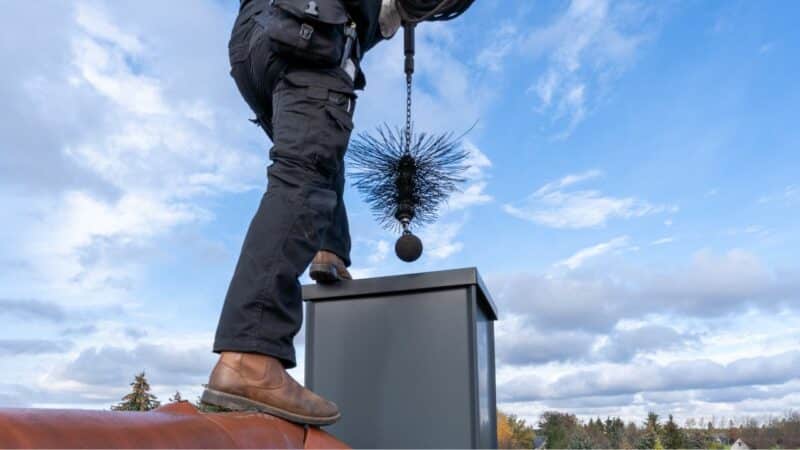
To minimize the risk of storm damage to your prefabricated chimney, consider the following preventive measures:
1. Schedule regular maintenance and inspections with a certified chimney sweep
2. Upgrade to a sturdier, more durable chase cover designed to withstand heavy snow and ice loads
3. Ensure proper sealing and waterproofing around the chimney pipe and chase to prevent moisture intrusion
4. Keep trees and branches trimmed away from the chimney to avoid falling debris during storms
5. Consider installing a chimney cap to prevent water, animals, and debris from entering the flue
An ounce of prevention is worth a pound of cure. If you stay mindful of protecting your chimney you can save yourself the expense of a full chimney renovation. Be mindful of how your chimney is being impacted by the weather and be quick to look with your own eyes at how moisture might be impacting your fireplace.
Identifying Storm Damage to Your Prefabricated Fireplace and Chimney
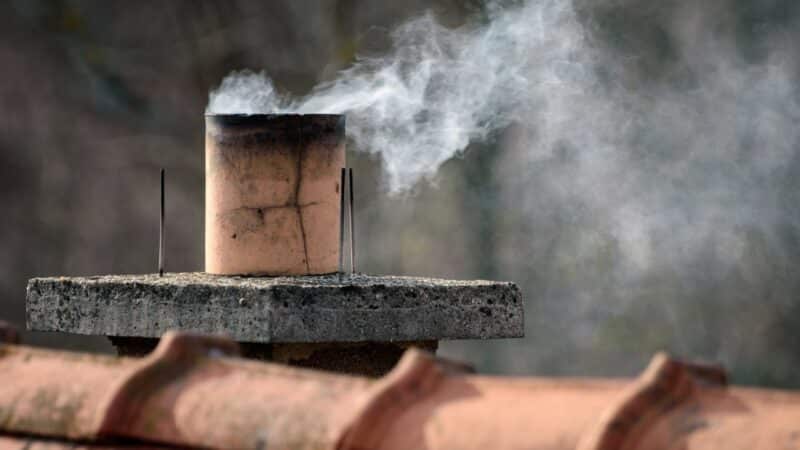
Regularly inspecting your prefabricated chimney can help you spot signs of storm damage early on. Some key indicators include:
1. A sagging or deformed chase cover
2. Water stains or leaks inside your home near the fireplace
3. Visible rust or corrosion on the chimney’s exterior components
4. Cracked or missing siding materials around the chase
5. Dampness or a musty smell in the fireplace or adjacent rooms
If you notice any of these signs, it’s essential to schedule a professional inspection as soon as possible. The National Fire Protection Association (NFPA) recommends annual inspections of all chimneys, regardless of the fuel type used. A qualified chimney sweep can identify hidden damage and potential hazards, ensuring the safety and efficiency of your heating system.
The Importance of Professional Chimney Inspections
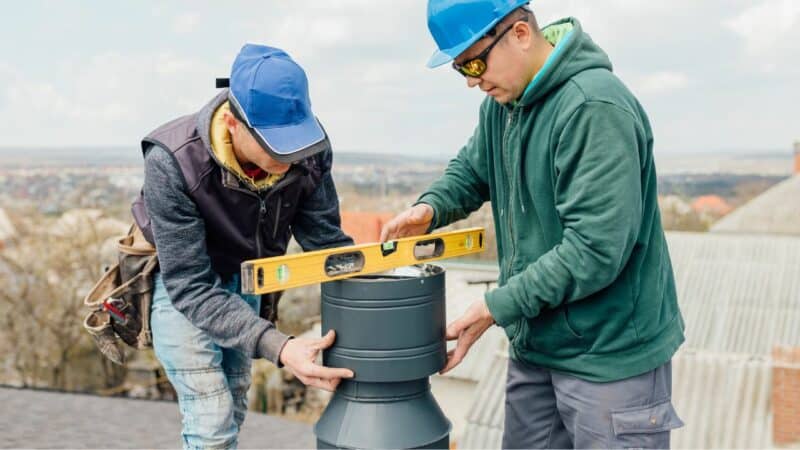
The number one way to protect your chimney, save yourself money on renovations, and utilize your homeowners insurance properly is by scheduling regular annual inspections. Annual chimney inspections are crucial for maintaining the safety and performance of your prefabricated fireplace and chimney. A certified chimney sweep will:
1. Thoroughly examine the entire chimney system, including the firebox, flue, chase, and exterior components
2. Check for signs of water damage, rust, corrosion, and structural issues
3. Ensure proper clearances and venting to prevent fire hazards and carbon monoxide leaks
4. Clean the chimney to remove creosote buildup, debris, and any animal nests or blockages
5. Provide recommendations for necessary repairs or replacements
By investing in regular professional inspections, you can catch potential problems early, avoid costly repairs, and ensure your family’s safety. But, the real value in upgrading to an NFPA level 2 inspection is the weight that inspection carries with your insurance company.
The Role of Homeowner’s Insurance in Protecting Your Prefabricated Chimney

Since we’ve worked with hundreds of homeowners in Portland, we have experience helping them maneuver the intricacies of their homeowners insurance policy. One of the greatest pieces of news we can give a homeowner is that their insurance might cover the significant damage from a winter storm. It’s not a given but there are clear steps in place that make it more likely your standard policy will cover the bill. Meet with your own insurance agent for information about your personal policy to understand your policy’s coverage and limitations. Here are our recommeded steps if you find your have storm damage:
1. Review your insurance policy to determine if it covers damage to your prefabricated chimney system
2. Document any storm damage with photos and contact your insurance provider promptly
3. Schedule a NFPA Level 2 Inspection. The documentation is your ticket to getting covered.
4. When you submit your paperwork you are looking for “The material adhesions were broken because of the ice which cauesd the expansion/contraction to take place.” Usually this phrase on your inspection demonstrates a “sudden occurence resulting in a loss of property value.
5. Submit the NFPA Level 2 as evidence on your claim and wait for a response.
By working closely with your insurance provider and maintaining proper documentation, you can increase your odds of getting covered.
Conclusion
Portland’s winter storms can cause significant damage to prefabricated fireplaces and chimneys, leading to potential safety hazards and costly repairs. By understanding the risks, identifying signs of damage, and taking proactive steps to maintain and protect your chimney system, you can keep your home warm and safe throughout the cold months.
If you suspect storm damage to your prefabricated fireplace or chimney, don’t hesitate to contact a professional for an inspection and any necessary repairs. At Portland Fireplace and Chimney, our experienced team is dedicated to ensuring the safety and efficiency of your heating system. Contact us today to schedule your inspection and protect your home from the elements.
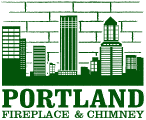
Portland Fireplace and Chimney Inc is your top notch pick for a fireplace and chimney company in the greater Portland metro area.

